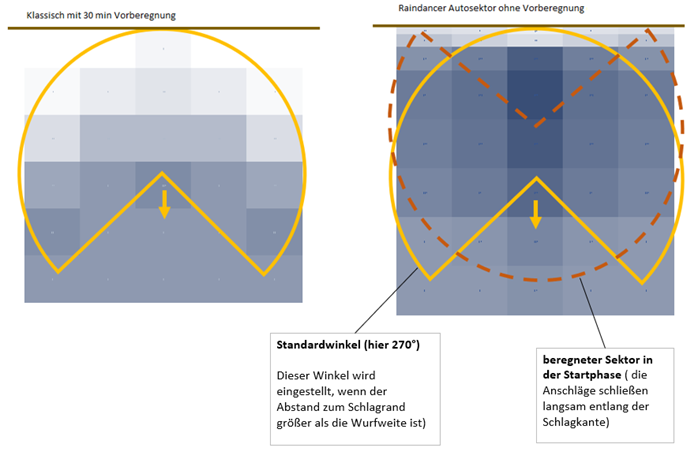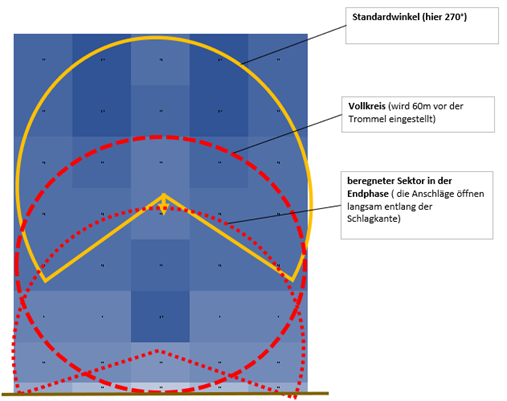Water Distribution with Sector Control at the Start and Finish
WennIf Sieyou mitwork demwith the raindancer undand dersector Sektorsteuerungcontrol, arbeiten,you könnencan Sieirrigate amright Startto undthe amborder Zielat bisthe anstart dieand Schlagkanten beregnen.finish.
In unseremthis Filmfilm sehenyou Siecan nochsee einmalhow dieit Arbeitsweiseworks …in action ...
UmTo zusee sehen,what wiethe diewater Wasserverteilungdistribution hierlooks reallike aussieht,in habenreality, wirwe took Messungenmeasurements zurof Wasserverteilungthe water distributionvorgenommen.. WirWe habenplaced dafür jeweils ca.approx. 100 Messbechermeasuring cups in diethe Flächearea gestellt,in umorder wirklichto brauchbareobtain undtruly interpretierbareuseful Messergebnisseand zuinterpretable bekommen.measurement results.
SoThis sehenis diewhat Ergebnissethe results look like: aus:
AmAt Startthe vergleichenstart, wirwe diecompare klassischethe Beregnungclassic mitirrigation with 30 min Vorberegnungpre-irrigation mitwith demthe Startstart unterusing Einsatzsector dercontrol. Sektorsteuerung.Here, Hierthe stehtgun dieis Kanonepositioned amat Schlagrand,the derborder Einzugof beginntthe sofortfield and the movement starts immediately.
The stops gradually close as it moves forwards. Once the full circle has been reached, the standard setting (270° in this case) is used to continue the run.
The measurement results show a significantly better distribution up to the boundaries of the field compared to the conventional method.
With conventional irrigation, approx. ¼ ha is not or barely irrigated (on average, only 25% of the planned precipitation is applied).
DieLet's Anschlägeassume, schließenone sichapplication beimper Vorrückenday langsam. Ist der Vollkreis erreicht, wird mit der Standardeinstellung (hier 270°) weitergezogen.
Die Messergebnisse zeigen gegenüber der herkömmlichen Methode eine deutlich bessere Verteilung bisand an denirrigation Feldrand.
Bei der herkömmlichen Beregnung wird ca. ¼ ha nicht oder kaum beregnet (hier kommen im Durchschnitt nur 25% der geplanten mm an).
Gehen wir beispielsweise von einer Umsetzung pro Tag und einem Beregnungszyklus vonof 8 Tagendays. aus.This Dascorresponds entsprichtto danna einemgain Gewinnin beregneterirrigated Flächearea vonof ca.approx. 2 ha jeper Trommel!hose reelNur! amJust Schlaganfang.at the start of the run.
AuchWe fürhave diealso Wasserverteilungtaken aminitial measurements for the water distributionEnde desat Beregnungsgangesthe end of the irrigation runhaben wir- erstehere Messungenare durchgeführtthe – hier die Ergebnisse.results.
GrundsätzlichBasically, habenyou Siehave imthe option in the raindancer dieto Möglichkeit,set fürthe denirrigator Regnerwith mitsector Sektorsteuerungcontrol einzutragen,to dassautomatically switch to full-circle irrigation (z.B.e.g.) 60 m vorbefore derthe Trommelhose automatischreel. aufThis Vollkreisberegnungmeans gegangenthat wird.irrigation Damitis wirdalso vor,provided umin undfront hinterof; deraround Trommeland auchbehind beregnet.the Derhose Vollkreisreel. öffnetThe sich,full wenncircle dieopens Wurfweitewhen gegenthe diethrow Schlagkantedistance kommt.comes close to the edge of the field.
SieEffective sehen,water dassdistribution wiris auchachieved hier eine gute Wasserverteilung erreichen.here.
WennWhen diethe Trommelhose imreel Schlagis vor dem Vorgewende stehen muss, wird trotzdem bis gegen die Schlagkante mit Vollkreis beregnet. Natürlich bleiben dann – abhängig von der Wurfweite - links und rechtspositioned in denthe Eckenfield kleinerebefore unberegnetethe Flächen.headland, it continues to irrigate in a full circle up to the field's border. However, depending on the throw distance, there may be smaller, unirrigated areas left in the corners to the left and right.
SieAt sehenboth amthe Startbeginning undand auchend amof Endethe desirrigation Beregnungsgangesrun, kleinereyou Flächenmight amnotice Schlagrand,smaller diepatches zuat wenigthe Wasserfield's bekommen.edge Auchthat hierreceive habeninsufficient Siewater. dieIn Möglichkeit,these dieseinstances, Flächenyou nachcan „draußen“extend außerhalbthese Schlagesareas zubeyond schiebenthe undfield's wirklichboundary bisto ensure optimal irrigation right up to the field's edge.
How is this accomplished? By either reducing the throw distance or by marking an diearea Schlagkanteoutside heranthe optimalfield zuand beregnen.Wie?setting -the z.B.,status indemto Sie"Allow die Wurfweite verringern oder eine Fläche über den Schlag hinaus einzeichnen und definieren, dass hier der Status „Beregnung erlauben“ gilt.irrigation."
NatürlichNaturally, müssenit Sieis hierimportant berücksichtigen,to obconsider amif Schlagrandthere einis Feldwega oderfield einepath Autobahnor läuft.a highway along the field's border.
AuchPreliminary fürmeasurements diefor Wasserverteilungwater bei Selbstfahrern (z.B.distribution in denself-propelled Kurven)machines, habensuch wiras erstein Messungencorners, durchgeführthave -been wirconducted, sindbut hierwe aberare nochcurrently "mittendrin".still Sobaldevaluating. wirWe auchwill hierprovide Ergebnisseupdates haben,once werdenwe wirhave Sieconclusive informieren.results.
Bei unserer Sektorsteuerung handelt es sich um eine Neuentwicklung. Es kann also immer sein, dass irgendwo noch „Ecken und Kanten“ sind.
Bei Hinweisen und Fragen: rufen Sie uns an!






